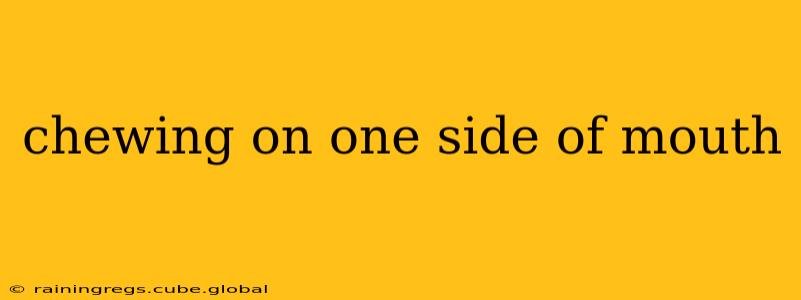Chewing predominantly on one side of your mouth is a common habit many people experience without realizing it. While it might seem like a minor quirk, persistently chewing on one side can lead to several oral health issues. This comprehensive guide explores the potential causes, associated concerns, and effective solutions to help you achieve balanced chewing and maintain optimal oral health.
Why Do I Chew on One Side of My Mouth?
This seemingly simple question has several potential answers. The reasons can range from simple habits to underlying medical conditions. Let's explore some of the most common:
-
Existing Dental Issues: A damaged tooth, a poorly fitting crown or filling, gum disease, or temporomandibular joint (TMJ) disorder can make chewing on one side more comfortable than the other. Pain or discomfort naturally leads you to avoid the affected area.
-
Habit: Many people develop a chewing habit on one side simply because they've always done it. It's a subconscious behavior that's hard to break without conscious effort.
-
Muscle Imbalance: Over time, consistently chewing on one side can lead to an imbalance in the jaw muscles. This can further reinforce the habit and make it harder to switch sides.
-
Jaw Misalignment (Malocclusion): If your teeth don't align properly, chewing on one side might be more efficient or comfortable.
-
Facial Nerve Damage: In rare cases, nerve damage affecting the facial muscles can make chewing on one side difficult or painful.
What are the Problems with Chewing on One Side?
Ignoring the habit of one-sided chewing can lead to a number of oral health problems:
-
TMJ Disorders: Consistent one-sided chewing puts extra stress on the temporomandibular joint, potentially leading to TMJ disorders, characterized by jaw pain, clicking, and limited jaw movement.
-
Uneven Jaw Muscle Development: One side of your jaw will become significantly stronger than the other, potentially leading to facial asymmetry over time.
-
Dental Wear and Tear: The teeth on the preferred side will experience increased wear and tear, leading to premature wear, chipping, and potentially needing more dental work.
-
Gum Recession: Increased pressure on one side can lead to gum recession on that side, exposing the tooth roots to increased sensitivity and potential decay.
Can Chewing on One Side Cause Facial Asymmetry?
Yes, persistent one-sided chewing can contribute to facial asymmetry. The stronger jaw muscles on one side can cause that side of the face to appear more developed than the other, leading to a noticeable imbalance in facial features.
How Can I Stop Chewing on One Side?
Breaking a long-standing habit requires conscious effort and potentially professional help. Here are some strategies:
-
Become Aware: Pay attention to which side you habitually chew on. This is the first step towards changing the behavior.
-
Consciously Switch Sides: Make a deliberate effort to chew on the opposite side. Start with small amounts of food and gradually increase.
-
Strengthen Weaker Muscles: Gentle jaw exercises can help strengthen the muscles on the less-used side. Consult a dentist or physical therapist for recommendations.
-
Address Underlying Dental Issues: If you suspect dental problems are contributing to the habit, see a dentist for an examination and treatment.
-
Consider a Mouthguard: If you have TMJ disorder, a mouthguard might help protect your teeth and jaw joint.
When Should I See a Dentist or Doctor?
If you're experiencing jaw pain, discomfort while chewing, noticeable facial asymmetry, or have difficulty chewing on one side, consult your dentist or doctor. They can determine the underlying cause and recommend appropriate treatment. Ignoring the problem could lead to more serious oral health issues in the long run.
By understanding the causes and potential consequences of chewing on one side of your mouth, you can take proactive steps to improve your oral health and achieve a more balanced chewing pattern. Remember, consistency is key when breaking habits, and seeking professional help can significantly aid the process.
